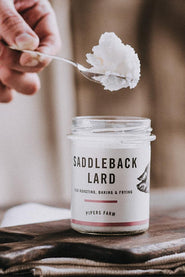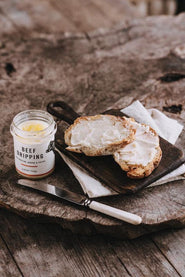Cooking without fat is almost impossible, whether you’re a staunch user of oils or butters, many of us reach for fat before any other ingredients grace the dish. This is because fat plays such an important role in the kitchen, from stopping food from sticking, imparting flavour or adding richness and viscosity to the dish.
What are the Different Types of Fat?
It is important to understand the structure of various fats in choosing what to use them for.
Polyunsaturated Fats
Unhydrogenated Polyunsaturated Fats are very unstable, they oxidise easily and when heated too high they can become damaging to our body. Once taken to hot the fatty acids can suppress our immune system. However if eaten in the foods they occur in, in their natural state, like seeds, nuts and oily fish they are brilliant for boosting our omega 3.
Monounsaturated Fats
Found in olive oil, avocados and nuts, monounsaturated fats provide food for beneficial bacteria and can improve the good to bad ratio of cholesterol in your blood. Just like Polyunsaturated fat, they are unstable and so it is ideal to eat them uncooked or gently heated.
Saturated Fats
Our body needs saturated fat to repair cells. Not having enough saturated fat can inhibit our ability to make vitamin D. Saturated fat, from pasture fed livestock, has a high proportion of CLA, which is credited for fighting cancer and preventing heart disease. Saturated fats are often the most enjoyable to cook with, from mostly animal byproducts they tend to impart flavour and the mouth-feel in dishes that signifies fat is present.
Trans Fats
Found in highly processed foods like margarine. They are incredibly difficult for our body to process because they interfere with our natural insulin production, promoting diabetes and obesity. In my opinion, trans fats have no place in the kitchen, not only are they awful for our bodies, they taste dreadful and have an unpleasant texture.
Pork Fat
In the early twentieth century, lard was the most popular fat in the country. It was used for everything from shining shoes to frying and baking. Today lard doesn't even make the top 50 fats used in our kitchen. This partly due to the rise in processed vegetable oils which have taken the place of lard in the kitchen, but also in part due to the change in which we rear pigs.
Over the last 50 years, pigs have been bred leaner and leaner. In industrial systems pigs are killed so young they are not given the chance to lay down a proper proportion of fat.
Pigs naturally have one of the highest meat to fat ratios of any livestock, their fat though, is not the same the whole way across the carcass. Pigs are made up of different types of fat; belly fat, caul fat and back fat.
You'll find back fat or 'lardo' as the name suggests across the back of the animal, but you'll also find it in areas such as the shoulder and rump.
Back fat is mostly sold in large chunks. It can be used for an array of kitchen projects to keep your finished creation moist like; charcuterie, terrines, pate, and sausages. Rendered it is excellent for sauteing or frying. Or you can simply slice it thinly and eat on toast.
Belly Fat is made up of layers of meat and fat. It is where we take our streaky bacon and pork belly from.
Caul fat is the web-like membrane that wraps around the pig's intestines. It is most commonly used as a casing to wrap ingredients.
Pork fat or lard, is made up of a mixture of saturated, polyunsaturated and monounsaturated fatty acids. Lard has a low level of polyunsaturated fatty acids, this means it doesn't turn rancid easily and makes pork fat an excellent ingredient in the kitchen.

Beef Fat
Beef contains two types of fat the external fat found just below the skin, and the fat also known as 'marbling' laced through the meat. Fat is such an important part of a beef carcass, a good fat covering allows a carcass to be aged for longer and the combination of the fat and aging significantly adds to the depth of flavour of the meat. Beef carcasses are made up of different types of fat; suet, marrow and dripping.
Marrow is found in the bones of the animal, in higher quantities through the hard-working leg bones. It not only tastes incredible, with a rich velvety mouthfeel but it's also incredibly good for you.
Dripping (or Tallow) is simply rendered beef fat. It imparts the most unctuous beefy flavour that is perfect for building up levels of flavour in sauces, stocks or in browning meat.
Suet surrounds the kidneys, it is a very hard fat with a crystal-like structure, this makes it an excellent ingredient for pastry. As it has less 'beefy' flavour than other areas of fat it can be used for both sweet and savory dishes. Its high melting point also makes suet a great choice for any high heat cooking.
Poultry Fat
Poultry fat is low in polyunsaturated fatty acids, making it very good for any sort of cooking from high-heat frying to gentle roasting.
All poultry fat, especially chicken, contains a high amount of palmitoleic acid which boosts our immune system, which is why often when we are unwell chicken soup is recommended.
As our birds are roaming freely on the farm, slowly building up a proper carcass, they lay down much more fat than most other chicken, especially industrially produced chicken. Their genetics come from a traditional French lineage that was designed to lay down proper healthy fat. This fat provides exceptional flavour to the meat.
Rendered poultry fat can be used to make the most incredible confit, creating the best roast potatoes or to simply impart flavour and all the brilliant nutrients in an array of dishes.
Ghee
Ghee is clarified butter that originating from India. It is typically prepared by simmering butter, which is churned from cream, skimming any impurities from the surface, then pouring and retaining the clear liquid fat while discarding the solid residue that has settled to the bottom.
Pure Ghee butter has immense healing benefits as it contains a balance of easy to digest fatty acids essential for healthy nerves and cells. Known for it anti-inflammatory properties, it is also rich with antioxidants and acts as an aid in the absorption of vitamins and minerals from other foods. Ghee has a high smoke point making it a useful ingredient in the kitchen.
Cooking Methods with Fat
Cooking on a High Heat
(Deep frying, frying, stir frying roasting with colour etc)
- Beef Dripping
- Lard
- Lardo
- Ghee
- Poultry Fat
Cooking on a Medium Heat
(Slow roasting, softening vegetables, cooking eggs etc)
- Beef Dripping
- Lard
- Ghee
- Poultry Fat
- Butter
- Coconut Oil
Cooking with No Heat
- Olive Oil
- Nut Oils
- Avocado Oil
Our Range of Fats
We utilise as much fat as possible across our range of products, turning it into something delicious for you to enjoy, you can shop our collection of pure fats including: Grass Fed Beef Dripping, Saddleback Lard, Organic Ghee and Pure Goose Fat.
Or choose from some of our most delicious products that are rich in fat like: Saddleback Streaky Bacon and Confit Duck Leg.








